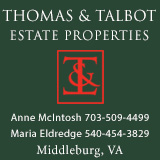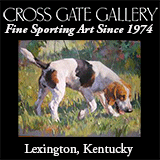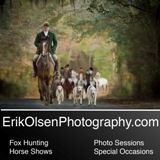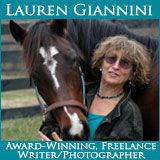Barclay Rives
Keswick Celebrates Its 125th
The Keswick Hunt Club is celebrating its 125th anniversary. Forces responsible for its longevity include the kindness of landowners, the hard work of professionals and volunteers, and the generosity of special angels. On December 10, 1896, nineteen foxhunting enthusiasts gathered at Cloverfields, the Keswick area home of Frank Randolph, to organize a club for “Social Intercourse and Fox and Drag Hunting.” The spirited gathering, which lasted until two a.m., elected Cary Ruffin Randolph Master of Foxhounds, and John Armstrong Chanler President. Chanler was an eccentric philanthropist who patrolled Keswick roads mounted and armed to enforce Virginia Code Section 2139 requiring automobile drivers to give horse traffic the right of way. Halting traffic for hounds and horses nowadays requires greater discretion. Foxhunting has been a feature of Keswick life since colonial days. According to sporting historians and family tradition, Dr. Thomas Walker (1715-1794) kenneled four couple of English Foxhounds at his home Castle Hill. Drafts from local farmer packs constituted the first Keswick pack. Some early members contributed hound puppies instead of dues―gentlemen $12/year, ladies $2/year―then claimed raising the puppies cost so much that the club owed them. Hunt club treasurers must contend with all varieties of explanations. Higginson and Chamberlain in their 1908 Hunts of the US and Canada declare the Keswick pack, then used for Saturday drag hunting and Thursday foxhunting, of inferior quality compared to the Keswick hunt horses, which included show champions belonging to Julian Morris, MFH. They suggest more attention be paid to the canine “arm of the service.” Little or no wire spoiled the country during the club’s early years. Jumps were high split rail fences enclosing pastures. Automobile traffic was minimal. Keswick members did not realize how lucky they were. Wire encroachment necessitated construction of dedicated hunt jumps beginning in the late 1920s. Despite periods of scarcity, inactivity, and political turbulence, Keswick has maintained good sport and good times. Hunting in the 1950s and 60s with Roberts Coles, MFH, was always lively and fun. Following Coles was the successful Mastership of Jake Carle, who served for thirty-six years from 1964-2000. Carle expanded Keswick’s territory into Orange, Louisa, and Madison Counties. He used mostly Bywaters bloodlines in Keswick’s American foxhound pack, which remain in the kennel today. Keswick recently completed a massive renovation and reconstruction effort. The clubhouse, built in 1898, was in danger of collapsing under the next heavy snow. The building has been reengineered, brought up to present day code and needs, while retaining its distinctive historic character. The kennels have been modernized, made more comfortable for hounds, and more easily maintained. A new staff horse barn, with huntsman’s cottage above, replaced a structure whose walls were caving in. Present Joint-Masters Will Coleman, Nancy Wiley, and Mary Kalergis have instituted frequent junior meets which have drawn many enthusiastic participants. New young faces in the hunting field and at the clubhouse offer a promising start to Keswick’s next 125 years. Posted January 18, 2022... This content is for subscribers only.Join NowAlready a member? Log in here
Read More
Keswick Hunt Club Marks its 125th
 Carrie Randolph Joslin hunting with Keswick, circa 1905
Carrie Randolph Joslin hunting with Keswick, circa 1905
The Keswick Hunt Club (VA) is celebrating its 125th anniversary. Responsible for the hunt’s longevity are its kind landowners, hard-working professionals and volunteers, and generous special angels.
Foxhunting was a feature of Keswick area life since colonial days. According to sporting historians and family tradition, Dr. Thomas Walker (1715-1794) kenneled four couple of English Foxhounds at his home, Castle Hill.
See You at Second Horses
This hunt report—a short but informative excerpt from Chapter 3 of Barclay Rive’s new book, See You at Second Horses—harks back fifteen years to when Barclay accompanied Rosie and Grosvenor Merle-Smith to England. The book recounts their hunting adventures during that trip and is available from Horse Country Saddlery, Warrenton, Virginia.
At the time, Grosvenor was Master and huntsman of the Bull Run Hunt (VA), and Barclay whipped-in to him. Barclay also whipped-in to the Keswick Hunt (VA)—sometimes to both hunts on the same day when Keswick met in the morning and Bull Run in the afternoon!
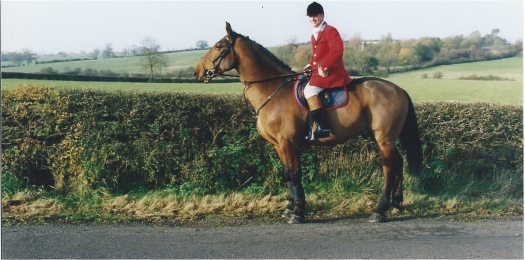 The author on Bruno at the Fernie meet at Billesdon / Rosie Merle-Smith photo
The author on Bruno at the Fernie meet at Billesdon / Rosie Merle-Smith photo
Julie and Colin brought our horses down the ramp out of the box. We had our first experience of what became a familiar routine: stepping up the ramp and using it as a mounting block for the horse led up beside it. I usually had to shorten my stirrups. Colin had to hold on to the horse’s head until I was done, because they were ready to go as soon as they felt weight in the saddle. Julie gave me instructions as I mounted a big bay.
“This is Bruno. He prefers a longer rein to a shorter one. He hunts with the Fernie every Saturday, so he knows his job.” This was her diplomatic way of telling me to stay off of the horse’s mouth and let him take care of me. I thought Bruno looked like he should be pulling a cart, but I was ignorant. He was a brilliant field hunter. An excellent teacher, Bruno was what American horse dealers call a packer, meaning he could pack me around as if I were a sack of grain. He was calm at checks, but ready to run and jump when the need arose. Sporting author Michael Clayton in Endangered Species reports that English foxhunters say the ideal hunting horse should have “the head of a duchess and the arse of a cook.” Bruno had plenty of muscle behind, and while his head was hardly elegant, he possessed beautiful brains.
Grosvenor, Rosie and I headed down the road where hounds had gone. Julie called to us, “See you at Second Horses.”





